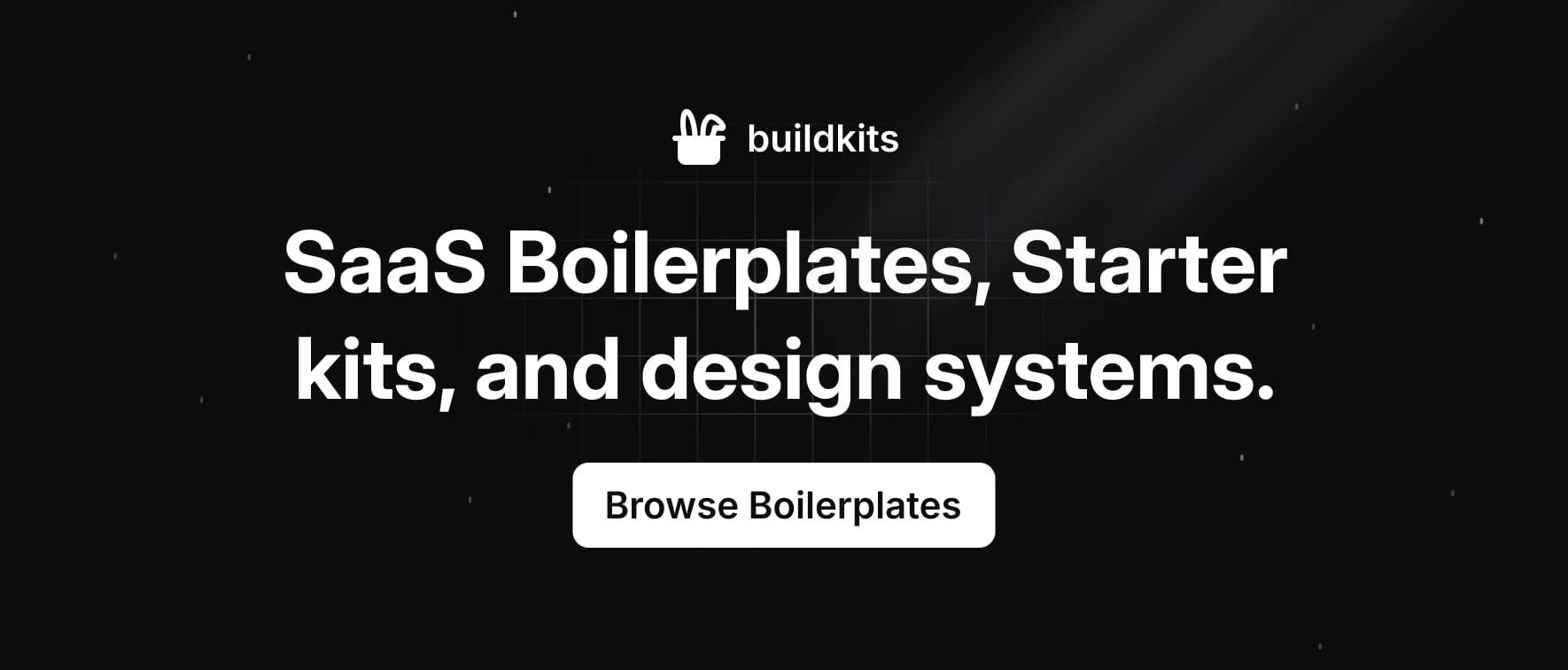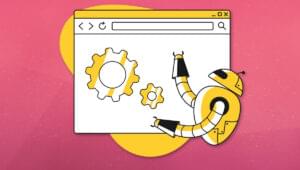Saving time from doing repetitive actions brings a special kind of satisfaction, and boilerplates allow you to do exactly that. Boilerplates refer to content (text or code) that can be reused without much or any change. SaaS boilerplates help you ship your SaaS application in a faster and possibly better way too.
This article will cover all you need to know about SaaS boilerplates. To help you choose the right SaaS boilerplate, I’ve also covered ten of my favourite boilerplates, too, but first, let’s start with what they are.
SaaS Boilerplates
SaaS boilerplates refer to pre-built codebases that support features common in SaaS applications. These features are usually the ones you see in most web and mobile applications — that is, user authentication, subscription management, billing systems, and so on.
It’s easy to underestimate how long these things will take to do, and morale can drop when you realize enough time has passed and you’re still working on these somewhat mundane tasks. Instead of building such features yourself, using a SaaS boilerplate can save time and give you a massive jump start.
Aside from saving time, boilerplates also help developers focus on the main point of the app — similar to how startup founders are encouraged to not get caught up in bookkeeping but instead to focus on the product. Developers can skip building common features and start building their app’s core functionalities earlier with boilerplates.
It sounds great, but what’s the catch? Well, they aren’t a fit for everybody. The following sections will help you decide if they’re good for you.
Do note that not all boilerplates are created equal quality-wise, so while talking about the benefits and cons of boilerplates, I’m considering a standard, reputable SaaS boilerplate. But worry not, as I list things to consider when choosing the right SaaS boilerplate, too.
Benefits of SaaS Boilerplates
Aside from accelerating development and saving both time and money, using a SaaS boilerplate can have the following benefits:
- Focus on core value. Developers can concentrate on building the core features of their SaaS application that differentiate the product rather than reinventing the wheel with common functionalities. They can save development time.
- Best practices. Boilerplates are often designed with the latest industry standards in mind, adopting secure and efficient coding practices that have been proven over time.
- Easier maintenance and updates. Since boilerplates often follow standardized coding practices and are well-documented, maintaining and updating the application becomes more straightforward.
- Faster time to market. Beyond just the speed of initial development, using a boilerplate can lead to a faster time to market for new features and updates. This agility can be a key factor in competitive markets where being first or quick to adapt can define success.
- Scalability. SaaS boilerplates are generally designed with scalability in mind, offering codebases and infrastructure setups that support growth. They’re a great way to develop multi-tenant applications.
- Community and support. Many boilerplates come with access to a community of developers and documentation, which is helpful for both troubleshooting and learning.
Ideal users for SaaS boilerplates
Considering the above benefits, the following would benefit greatly:
- Startup founders and entrepreneurs. For those aiming to launch their product quickly to validate business ideas or capture market opportunities.
- Freelance developers, small to medium-sized teams. Devs or teams that need to maximize resource efficiency and focus on delivering innovative features rather than foundational functionalities.
- Rapid prototyping needs. When the goal is to quickly prototype a concept for feedback, boilerplates offer a fast track to a working model.
- Developers improving their craft. A great resource for learning through practical application and getting up to speed with the best coding practices. But try to use only the free SaaS boilerplates for this purpose.
Cons of SaaS Boilerplates
Despite their advantages, SaaS boilerplates come with certain drawbacks that can make them less than ideal for some projects:
- Generic solutions. Boilerplates provide a one-size-fits-all solution that may not meet the specific needs or requirements of more specialized projects.
- Unnecessary bloat. Boilerplates can include features and code that are not needed for a particular project.
- Initial setup overhead. Despite the aim of speeding up development, initial setup and configuration of the boilerplate to suit specific project needs can slow down development initially.
- Customization challenges. Tailoring a boilerplate to fit specific project requirements can sometimes be as complex as building from scratch, especially if the boilerplate is heavily opinionated.
While there are other things like performance concerns or the potential for abandonment (no updates as the tech stack improves), such things aren’t a concern for reputable SaaS boilerplates, as they will follow industry standards and offer ongoing support and updates to ensure compatibility with the latest technologies.
Still, SaaS boilerplates probably won’t be the best choice for:
- Highly customized projects. Projects that require a unique set of functionalities might find boilerplates restrictive and more tedious to customize.
- Developers and teams with established codebases. Devs, or teams that already have a mature development process and codebase, may find integrating a boilerplate more trouble than it’s worth.
Things to Consider When Choosing
There are several things you must ensure before choosing a SaaS boilerplate. These include:
Tech stack compatibility. The boilerplate should match your preferred tech stack; nothing can help you if you’re not comfortable here. This includes any programming languages, databases, frontend frameworks, and other technologies you need to build your SaaS project.
Reputation. It’s important to research the credibility of the SaaS boilerplate provider to ensure they have a track record of delivering quality products and support. Here, reviews and testimonials will help gauge the reliability and effectiveness of the boilerplate.
Unfortunately, most boilerplates don’t offer free trials, so you can’t check these things (except the docs) out for yourself. That’s why the creator’s credibility will be your main guiding point. Asking popular developer-centric subreddits and Discord servers about their experience regarding certain boilerplates might be worth a try too.
Finally, after you’ve completed your initial vetting, you’re good to go if the boilerplate includes the features you need and meets your budget (but some are free too!).
10 Awesome SaaS Boilerplates!
SaaS web applications are potentially a very lucrative venture, but as people say, “When everyone digs for gold, sell shovels.” There’s been a surge of SaaS boilerplates on the market, creating uncertainty regarding quality.
But there are also developers like Cory Zue (SaaS Pegasus) and Kyle Gawley (Gravity) who realized how painstaking it is to build common features every time and built a quality SaaS boilerplate for their preferred technology stack only for it to end up a major commercial success.
While some boilerplates are mentioned here, it doesn’t include most of them. It’s worth checking out Buildkits which features over 150 SaaS boilerplates. You’ll also find various filters for tech stack on the sidebar, check out the results I find with Next.js and Postgres.
Although there’s no harm in trying out some of the newer boilerplates, especially if they’re free, using ones from reputable developers is recommended. Finally, here are some great boilerplates that cover the major frameworks:
Divjoy (React, Next.js)
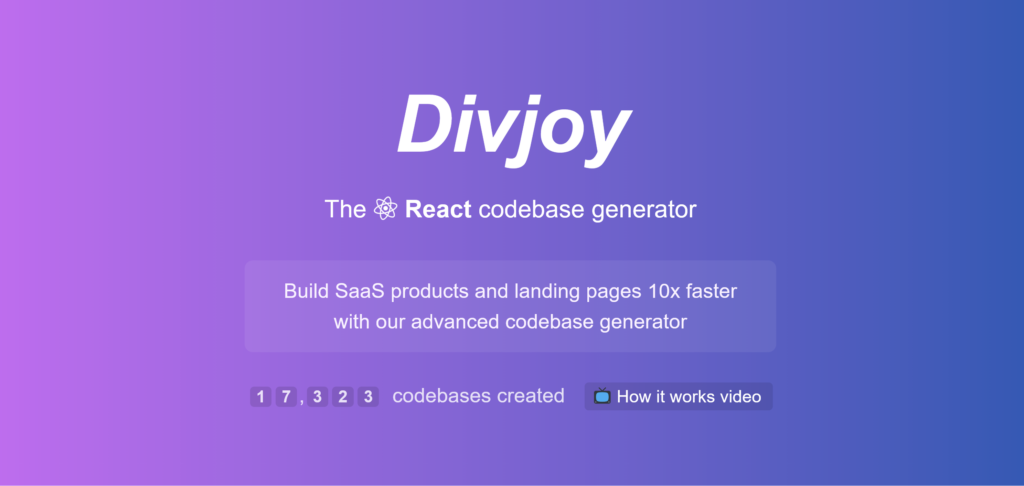
Divjoy is a React codebase generator that can create high-quality codebases tailored to developers’ specific needs. It’s also a UI generator that’s helpful for building landing pages.
Developers can choose from various frameworks (React, Next.js), UI kits (Material UI, Bootstrap, Bulma, Tailwind), and integrate with services for authentication (Firebase Auth, Supabase, Auth0), databases (Cloud Firestore, Supabase), payments (Stripe), and lastly, hosting (Vercel, Netlify).
Divjoy has been featured on Product Hunt, showcases various SaaS apps built with Divjoy and its founder is currently an engineer at Stripe, giving further credibility to his code quality.
Regarding pricing, Divjoy offers a one-time purchase deal of $129 (down from $299), which includes unlimited projects, access to pre-built SaaS templates, a selection of UI kits, and access to a private Discord community for support.
SaaS Pegasus (Python/Django)
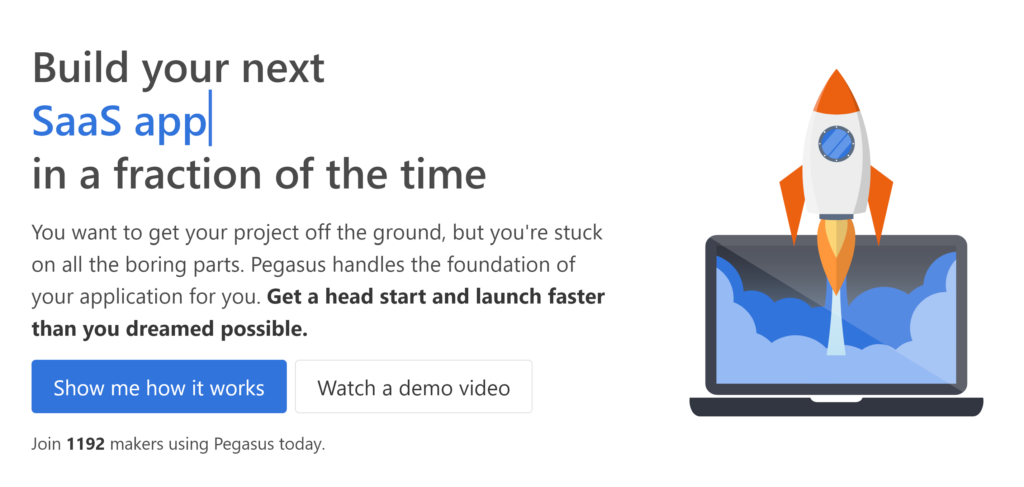
SaaS Pegasus is a Django-based SaaS boilerplate that supports rapid deployment and building web applications with a focus on modern UI, security, and scalability. It’s got great reviews, an active founder, and is an ideal choice for developers comfortable with Python and looking for a Django-based solution.
Features include admin UI, user impersonation, feature flags, two-factor authentication, flexible deployment, Docker-based development, and more. Pricing starts at $249 for the Starter package, with Professional and Unlimited options offering premium support and updates.
MakerKit (Remix, Next.js)
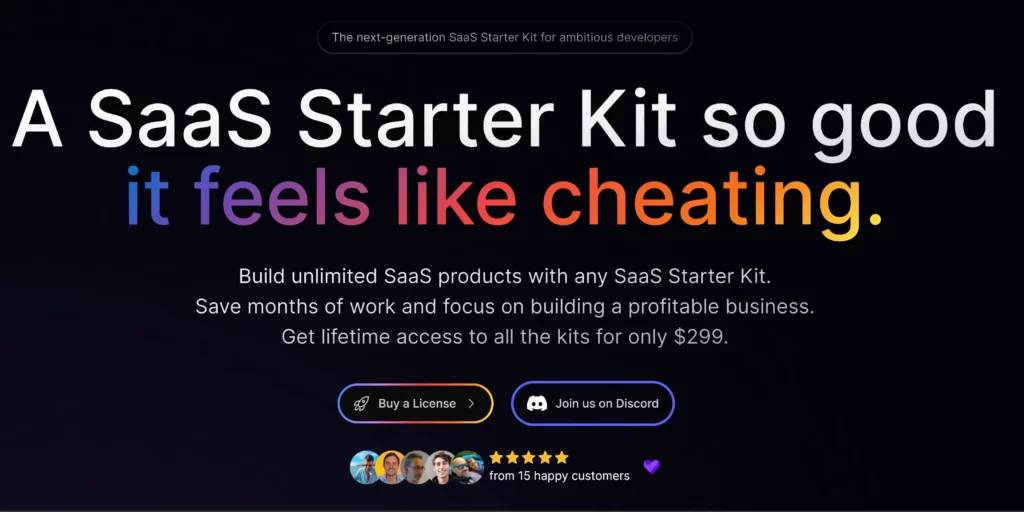
Makerkit is a comprehensive SaaS starter-kit built on a modern tech stack including Next.js, Remix, Firebase, Supabase, Tailwind CSS, and TypeScript.
Makerkit simplifies the creation of feature-rich applications with pre-built functionalities such as full authentication flows, multi-tenancy, Stripe payments integration, and a super admin panel. It supports both light and dark themes, leverages serverless architecture for ease of deployment, and emphasizes clean, customizable, and strictly typed code for optimal maintainability.
MakerKit has an active dev, and a growing number of testimonials on its main site.
Pricing tiers are tailored to various needs — Lite ($199), Pro ($299), and Teams ($599) — each offering lifetime access and support. The Pro and Teams licenses additionally provide access to advanced codebases, components, and plugins such as AI Chatbot, AI Writer, and Feedback Portal.
Bullet Train (Ruby on Rails)
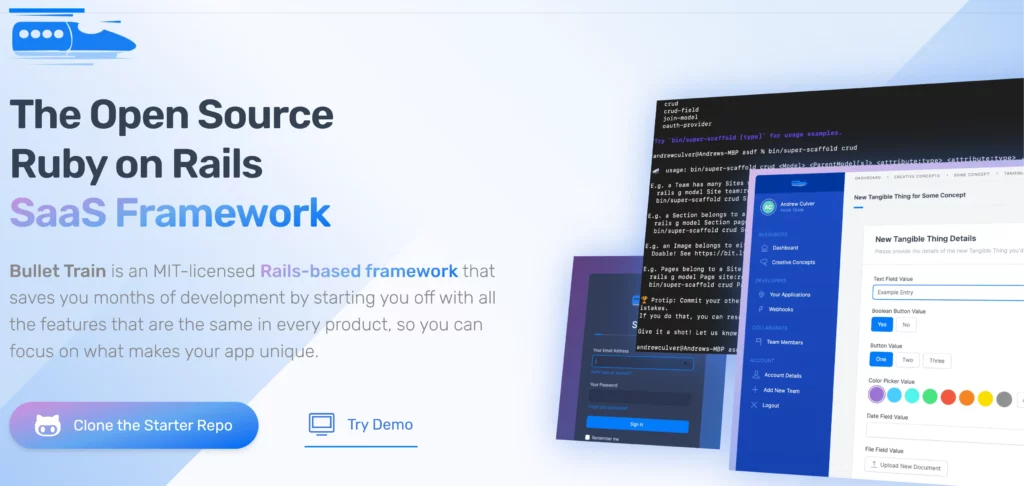
Bullet Train is an open-source Ruby on Rails SaaS framework that’s actively maintained by Andrew Culver, a long-time Rails developer.
This Rails-based solution includes user authentication (via Devise), teams and invitations management, security and permissions (with CanCanCan), roles, a professionally designed UI theme using Tailwind CSS, rich form fields, dark mode support, reactivity with ActionCable, a REST API (using Grape), webhooks, and full theme engine support.
It features detailed documentation and is MIT-licensed, which makes it free to use!
ShipFast (Next.js)
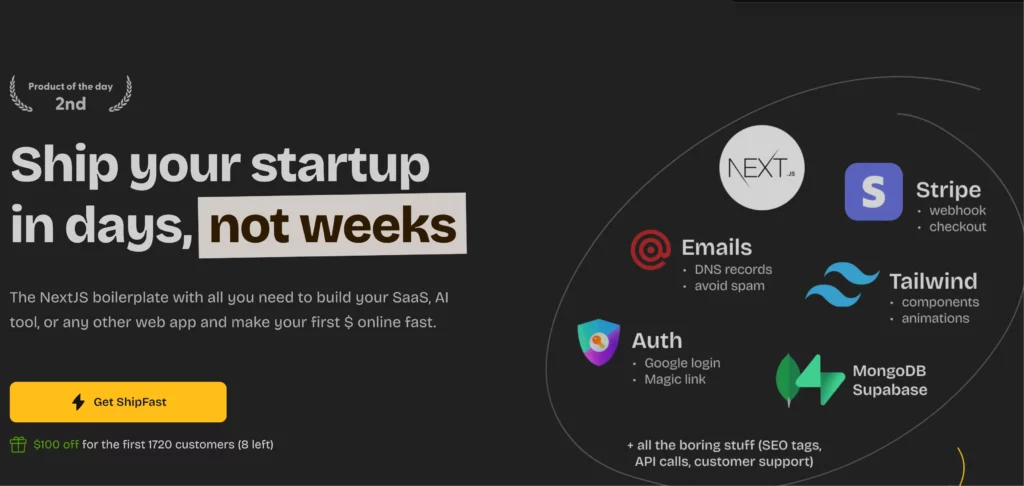
ShipFast is a NextJS boilerplate that provides pre-built functionalities such as user login (via NextAuth), payment processing (via Stripe), email handling (with Mailgun), database management via MongoDB/Supabase, SEO optimization, and a stylish UI with Tailwind CSS.
ShipFast features various app launches it has facilitated, has great reviews on Product Hunt, and is actively developed by a known solopreneur, Marc Lou.
It offers two pricing plans — Starter package at $169 (from $269) and an all-in package at $199 (from $299) — but the starter package would be a bad buy as it doesn’t include lifetime updates.
Gravity (React, Node.js)
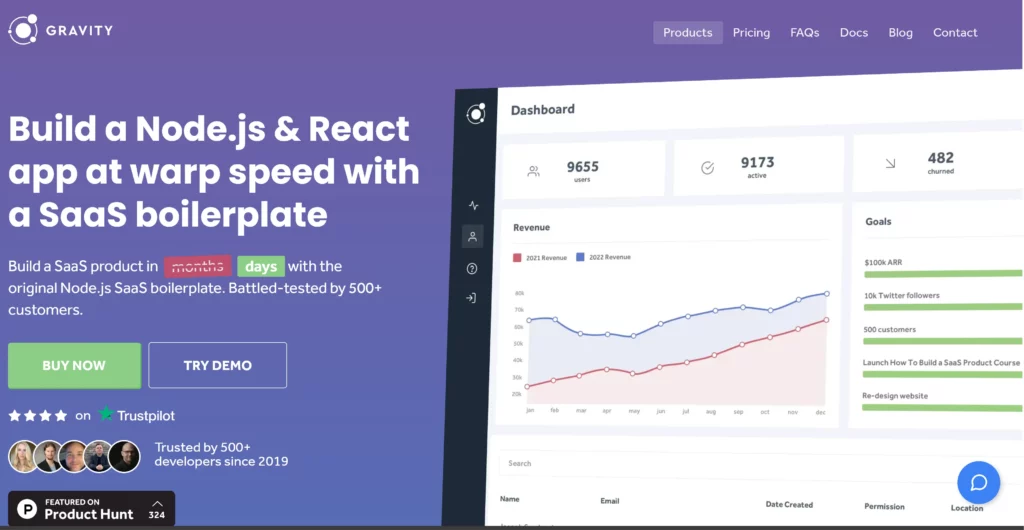
Gravity is a thorough Node.js and React SaaS boilerplate with great reviews, active founder, and claims to save three months of coding effort.
This boilerplate streamlines SaaS projects with Stripe payments, user authentication, React and Tailwind UI (with dark mode), localization, AI integrations, social logins, a REST API, multiple databases, team tools, email alerts, user accounts management, and many more pre-built components.
Its pricing plans range from $595 to $1595, and its costlier plan includes support for Gravity Native (based on React Native), which can help build native Android and iOS apps too. All plans offer support and one year of updates.
LaunchFast (Astro, Next.js, SvelteKit)
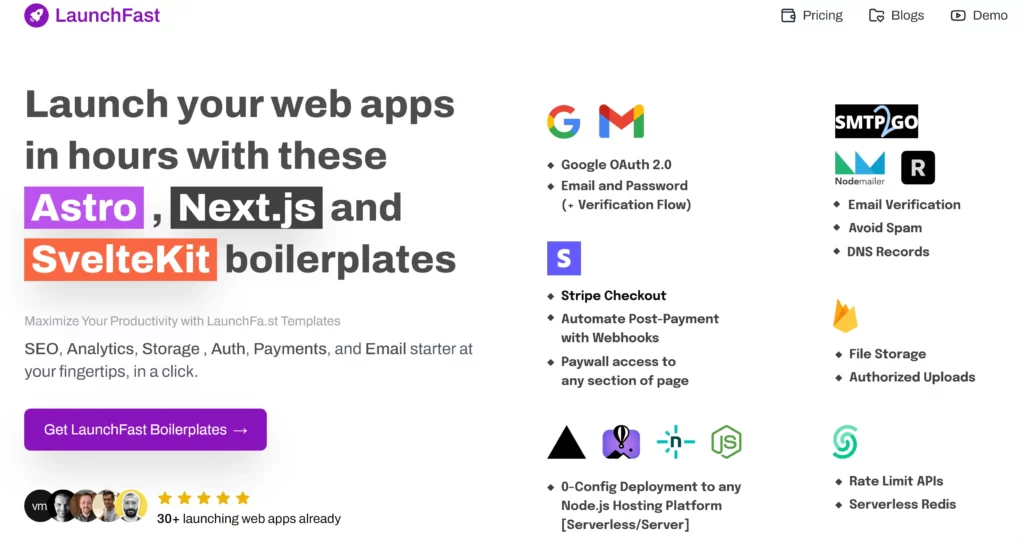
LaunchFast is a boilerplate built on Astro, Next.js, and SvelteKit, offering templates that save developers significant time on their SaaS app. It features a clear value proposition, easy-to-read documentation, a growing number of testimonials, and an active developer.
Key offerings include user authentication, analytics, payment processing, file and document storage, email services, serverless databases, and social media bots. LaunchFast offers these features via various means. For example, most boilerplates only support Stripe, while LaunchFast supports LemonSqueezy too, alongside Stripe.
Its pricing plans follow one-time payments for Astro at $75, Next.js at $79, and SvelteKit at $99, with all plans including priority support.
Apptension (Django, React)
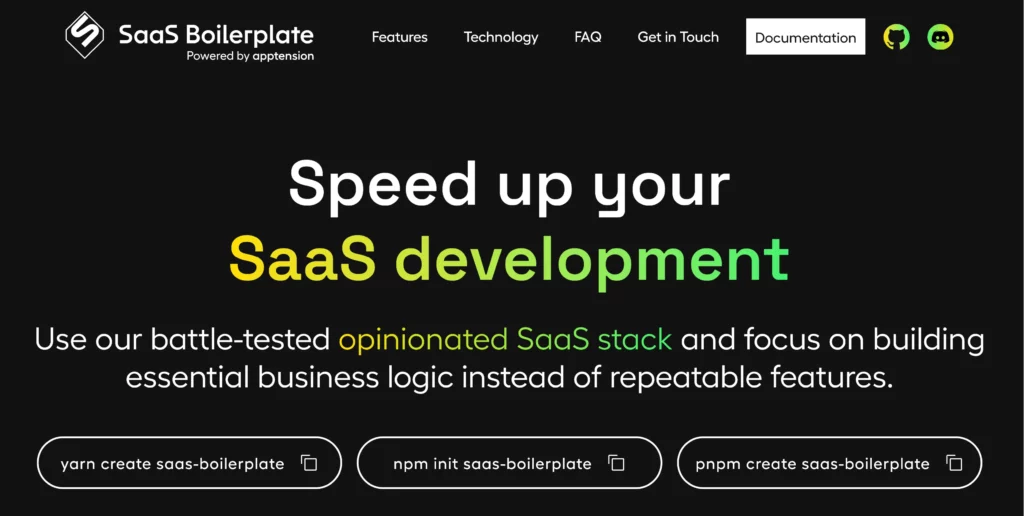
The Apptension SaaS Boilerplate is an open-source toolkit (4k+ stars) that can be installed on an AWS account, facilitating the development of an unlimited number of web applications. It’s powered by a credible organization, Apptension that has successfully worked with companies like Netflix, Uber, and so on.
Its frontend is built with React, utilizing GraphQL and Apollo Client for data management, and styled with Tailwind CSS. While the backend leverages Python with Django and the Django REST Framework for server-side logic, with Graphene Django supporting GraphQL queries, PostgreSQL is used as the database.
Aside from common features like user management, stripe billing, and so on, it supports CMS integration (specifically with Contentful), an admin panel, and CRUD operations. Apptension has open-sourced its boilerplate, allowing developers to use it for free!
ASP.NET Zero (ASP.NET)
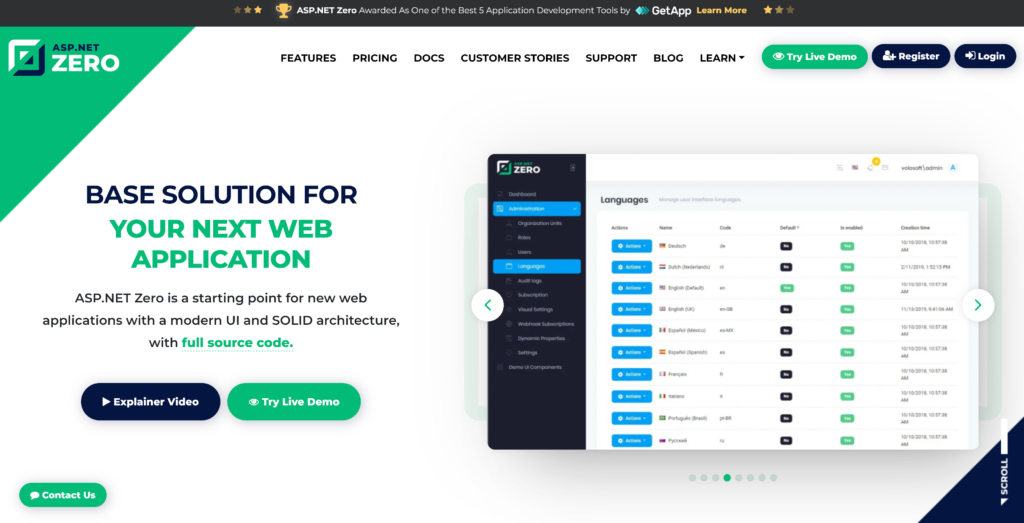
ASP.NET Zero is built on top of the ASP.NET framework and is a powerful choice for developers familiar with the Microsoft ecosystem. It has been used by major organizations like Microsoft, NASA, Comcast, and son on, and tops the credibility charts.
If you want to use ASP.NET for your SaaS project, you don’t need another boilerplate than this. It’s also one of the few boilerplates on this list that offers a demo, so you can test it out too!
This boilerplate features a complete SaaS development kit and includes all the features you could need to create a robust, multi-tenant application using ASP.NET.
Its pricing lives up to its quality too, with the lowest plan being $2999 and the highest being $9999, with all plans giving one-year updates to the full source code.
Jetstream (Laravel)
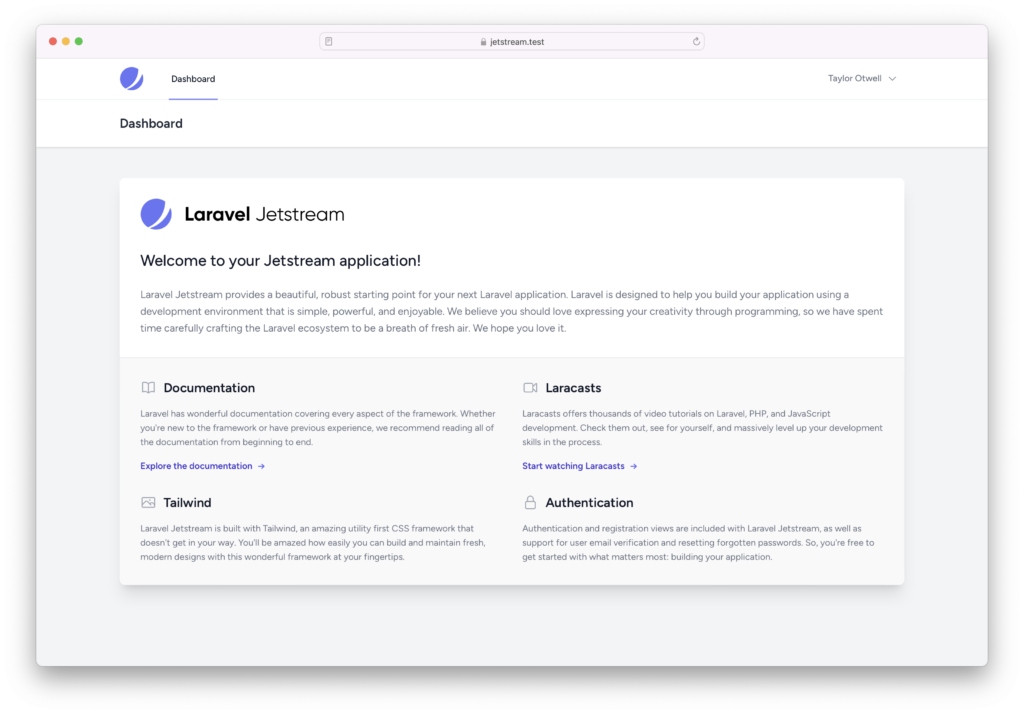
Jetstream is a Laravel-based starter kit offered by the creator of Laravel, Taylor Otwell himself. As an official package from the Laravel team, it offers a high degree of integration with Laravel’s ecosystem, making it a go-to for developers looking for a reliable and feature-rich starting point.
It includes features like user registration, authentication, email verification, session management, and team management features. While the backend is Laravel, developers have a choice between Livewire and Inertia for their frontend stack.
Jetsream is open-sourced (3.8k stars) and free to use, but those wanting a robust boilerplate geared toward billing might want to consider Spark, which is a paid option but also created by Taylor.
Conclusion
SaaS boilerplates can be an effective way to not only accelerate development time but also bring your product to market faster. There are a ton of boilerplates out there, so it’s important to choose carefully:
- Shortlist boilerplates via tech-stack using Buildkits, which is a more extensive list and includes prices too compared to Smirnov’s directory on GitHub.
- Compare the value proposition and see which one suits your use-case.
- See reviews and testimonials of boilerplate or developer’s past work.
By now, you should have a good starting point to choose the boilerplate ideal for you. Happy shipping!
 Zain Zaidi
Zain ZaidiZain is a software geek and techie who loves diving into technical stuff. His primary areas of interest include IoT, SEO, and SaaS. He's also interested in psychology and occasionally writes about it on his blog, Perception Pie.

